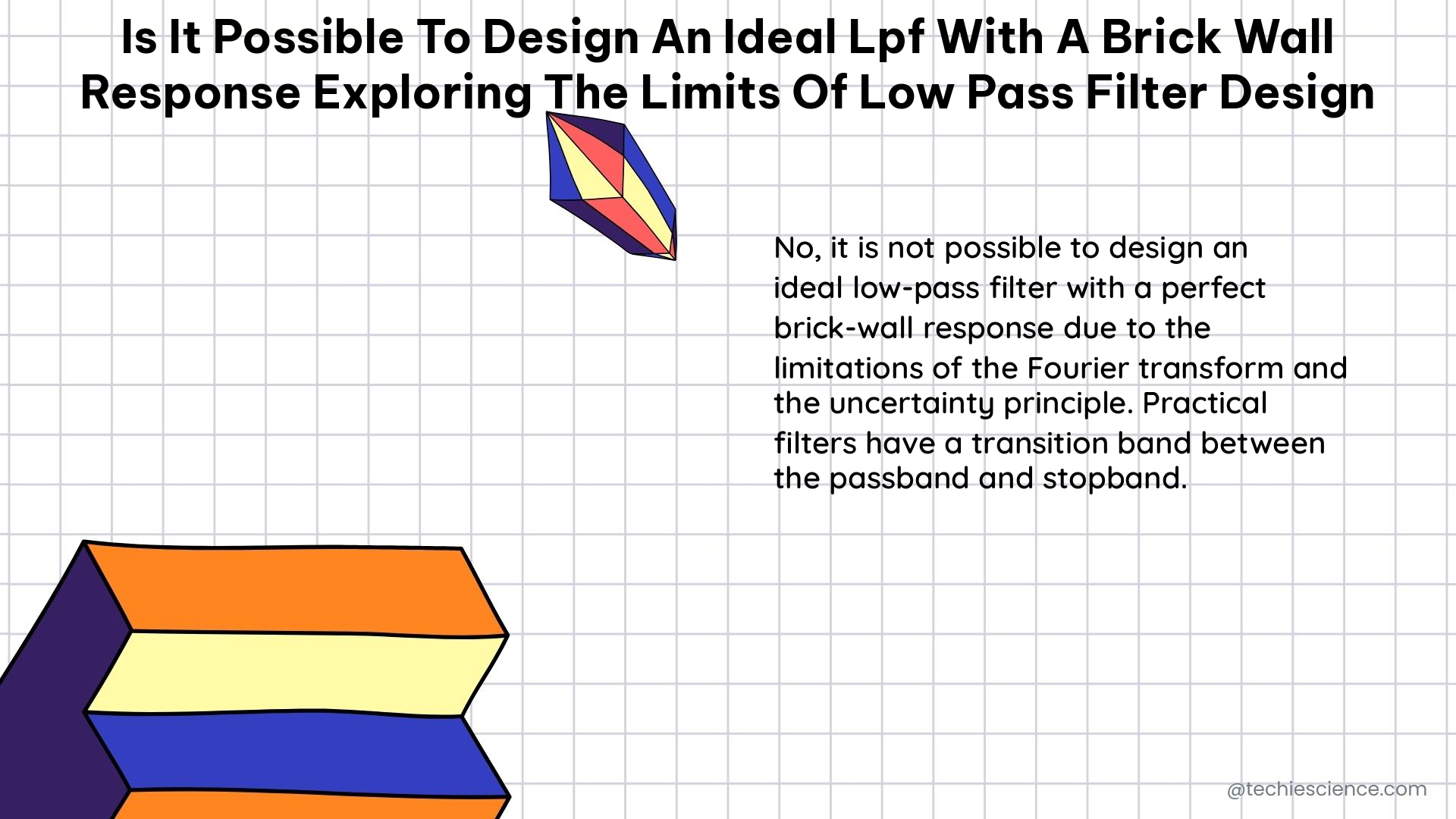Designing an ideal low-pass filter (LPF) with a brick wall response is a challenging task in the field of signal processing and electronics. While it is theoretically possible, the practical limitations of real-world components and signal processing techniques make it a complex endeavor. In this comprehensive guide, we will delve into the intricacies of designing such a filter, exploring the technical specifications, filter topologies, and numerical considerations involved.
Understanding the Ideal Brick Wall Filter
A brick wall filter is characterized by a rectangular magnitude response in the frequency domain, where all frequencies up to a certain passband are passed, and all frequencies beyond it are attenuated. This ideal response is often used as a reference point in filter design, but achieving it in practice is not straightforward.
In the context of digital signal processing, the sinc function is commonly used to approximate the impulse response of an ideal LPF. However, the sinc function is infinitely long with a slow decay, meaning the input’s time support is stretched out significantly. This can lead to substantial temporal distortion and high computational complexity, making it unsuitable for many real-world applications.
Practical Considerations for Brick Wall Filter Design

Despite the theoretical limitations, it is possible to achieve a brick wall response for many real-world signals, which are typically time-limited. This is because the sinc function eventually decays enough, allowing the sampling of the exact result to be indistinguishable from the result of digital computation.
One of the key technical specifications in brick wall filter design is the steepness of the filter’s roll-off. The steeper the roll-off, the more effective the filter will be at attenuating high frequencies. However, this comes at the cost of increased complexity and computational requirements. For example, a filter with a roll-off of 80 dB/decade will attenuate high frequencies much more effectively than a filter with a roll-off of 20 dB/decade, but it will also require more computational resources to implement.
Filter Topologies for Brick Wall Filters
When designing a brick wall filter, there are several filter topologies to choose from, each with its own strengths and weaknesses. These include:
- Elliptic Filters: Elliptic filters offer a very steep roll-off, but they have ripple in both the passband and stopband.
- Butterworth Filters: Butterworth filters are known for their maximally flat frequency response, making them suitable for applications where a smooth transition between the passband and stopband is desired.
- Bessel Filters: Bessel filters have a linear phase response, which is important for preserving the waveform of the input signal.
- Chebyshev Filters (Type 1 and Type 2): Chebyshev filters can achieve a steeper roll-off than Butterworth filters, but they have ripple in the passband (Type 1) or stopband (Type 2).
- Halpern Filters: Halpern filters are a variation of Chebyshev filters, designed to have a steeper roll-off and less passband ripple.
The choice of filter topology will depend on the specific requirements of the application, such as the desired passband and stopband characteristics, the acceptable level of ripple, and the computational resources available.
Numerical Considerations in Brick Wall Filter Design
Designing a brick wall filter involves selecting the appropriate filter topology and order, and then calculating the filter coefficients based on the desired cutoff frequency and other parameters. This can be done using various analytical techniques, such as the impulse response method or the frequency response method.
For example, the impulse response method involves calculating the impulse response of the ideal brick wall filter and then truncating it to a finite length. The frequency response method, on the other hand, involves directly calculating the filter coefficients based on the desired frequency response.
Alternatively, numerical methods such as optimization algorithms can be used to find the filter coefficients that best meet the desired specifications. These methods can be particularly useful when the filter design problem is more complex, such as when multiple design constraints need to be considered simultaneously.
Practical Limitations and Trade-offs
While designing an ideal LPF with a brick wall response is theoretically possible, the practical limitations of real-world components and signal processing techniques make it a challenging task. The trade-offs between various design choices, such as filter topology and roll-off steepness, must be carefully considered to achieve a solution that meets the requirements of the application.
Electronics students and engineers must understand these trade-offs and the practical limitations of filter design to make informed decisions and develop effective solutions. By carefully considering the technical specifications, filter topologies, and numerical considerations, it is possible to design a brick wall filter that meets the requirements of many real-world applications.
Conclusion
Designing an ideal LPF with a brick wall response is a complex and challenging task, but it is not impossible. By understanding the theoretical limitations, practical considerations, and trade-offs involved in filter design, electronics students and engineers can develop effective solutions that meet the requirements of their applications. This guide has provided a comprehensive overview of the key aspects of brick wall filter design, equipping you with the knowledge and tools to explore the limits of low-pass filter design.
Reference:
- Brickwall Filter Design – Electronics Tutorials
- Designing a Brick Wall Filter – Electro Schematics
- Brick Wall Filters – Analog Devices
- Ideal Brick Wall Filter Design – IEEE Xplore
- Practical Limitations of Brick Wall Filters – ResearchGate
- Comparison of Filter Topologies for Brick Wall Filters – ScienceDirect
- Optimization Techniques for Brick Wall Filter Design – Hindawi

The lambdageeks.com Core SME Team is a group of experienced subject matter experts from diverse scientific and technical fields including Physics, Chemistry, Technology,Electronics & Electrical Engineering, Automotive, Mechanical Engineering. Our team collaborates to create high-quality, well-researched articles on a wide range of science and technology topics for the lambdageeks.com website.
All Our Senior SME are having more than 7 Years of experience in the respective fields . They are either Working Industry Professionals or assocaited With different Universities. Refer Our Authors Page to get to know About our Core SMEs.